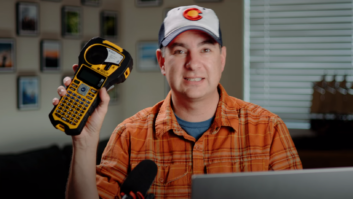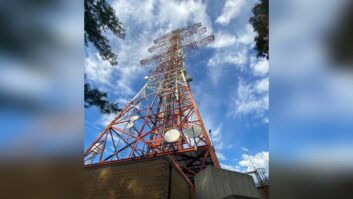
Jocks, fingers and knobs don’t always mix in the broadcast environment. I’ve seen studios where engineers have mounted critical gear high up in racks — requiring a stepstool for adjustment — or locked it in a rack room.
Nashville engineer Matt Aaron needed to mount equipment in a small studio but sought to discourage any adjustment. His solution was an enclosed rack fitted with snap-type brackets to hold a cover in place, similar to a transport case. As seen in Fig. 1, the cover snaps over the front of the rack, protecting the equipment from tampering.
***
Marvin Walther is chief engineer for Carroll Broadcasting in Tawas City, Mich. He registers his disdain about the USB connector taking the place of the mini jack in audio applications.
Marvin writes that the average audio guy will no longer be able to simply wire up a cable for an audio input and output. Another problem is the stability of USBs, such that it can’t be used in a pro audio setting.
Why? USB can disassociate from a particular port when rebooting the device; then your software mapping for the device goes out the window. Also, USB fails for no apparent reason because of fake power drains on the USB buss created by devices plugged into it — even when those devices aren’t taking power from the buss.
Another issue: USB drivers don’t always operate at top speed. USB is as slow and clunky to implement as any serial device, which impairs the transfers of high-frequency analog signals.
The humble analog audio or video jack may seem low-tech, not hip enough for modern-day interfacing, but it sure is a lot cheaper, simpler and more reliable than putting another weak-kneed piece of digital tech between your signal and transmission device or recorder.
One last point. At least analog cables are simple and can be serviced easily for opens or shorts. An analog cable requires no batteries or power sources to go bad. When USB goes flakey, how does a jock service that when on a live remote?
All good points about a pertinent issue for broadcasters.
***
USB drivers do, however, have their uses. Most stations I visit have performance areas — often sponsored — where listeners are invited to live performances, strengthening the bond between audience and station.
Alpha Media San Antonio Engineering Manager Jeff Caudell mounted several large 50-inch Samsung monitors in one room, a good way to display branding, client spots or upcoming station promotions. Jeff’s concern was allocating and mounting individual computers to drive the monitors.

As shown in Fig. 2, his solution was a 60-inch Samsung model that included a USB port and built-in media player. He set the screen to loop the slideshow or MP4 video. The promotions and IT folks then produced brief promo videos and slides, transferred them to USB sticks and inserted them in the ports.
The process is simple, and content can be changed easily on any of the monitors. This tip saves money over installing an individual computer to drive each monitor.
***
Lewis Callaway is a full-time student who does part-time engineering for KCMR Radio in Mason City, Iowa. The station was paying a large monthly fee for a low-bit-rate, low-listener-count Icecast streaming service.
As a self-described tightwad, he knew he could do something cheaper. Lewis ended up building his own Icecast server using a virtual private server so he didn’t eat up all the bandwidth at the studio.
When he was told the station needed stats, he thought he was going to have to write some complicated script but then found a great package called Centova Cast. Not only does it do all the stats the office staff needed, but it makes managing an Icecast server much easier. It’s only $60 a year for one station, a small price to pay for its convenience. Lewis says this is a great way for stations to save money on their web stream. A screen shot of Centova Cast is seen in Fig. 3.

Great Workbench tips often don’t need a workbench. Share your own ideas about streaming, apps, network management and other modern-day workplace challenges.
Send Workbench tips to [email protected]. Fax to (603) 472-4944. You’ll help your fellow engineers and qualify for SBE recertification credit.
Author John Bisset has spent 46 years in broadcasting and is still learning. He handles West Coast sales for the Telos Alliance. He is SBE certified and a past recipient of the SBE’s Educator of the Year Award.












